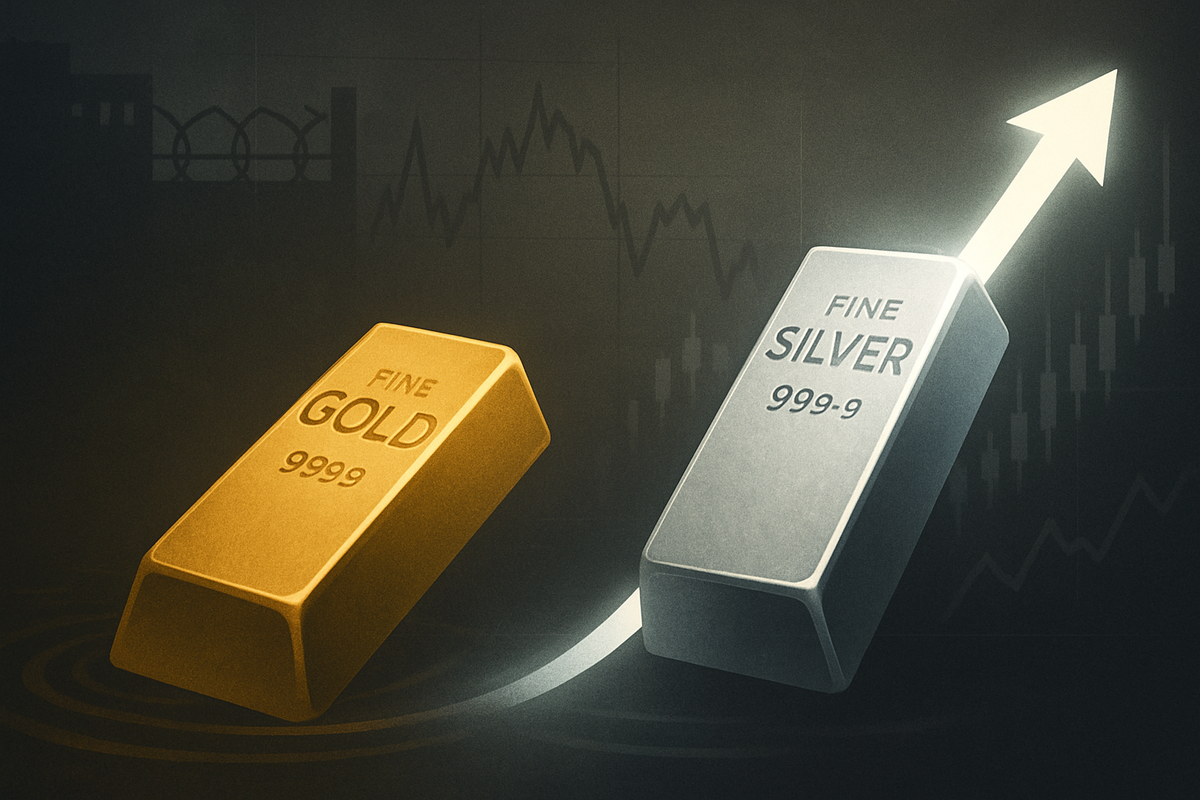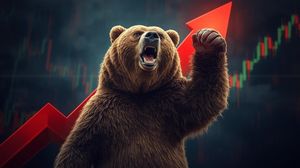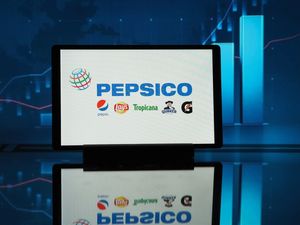
October 10, 2025 – The financial markets are currently witnessing a striking divergence in the performance of precious metals, a phenomenon largely attributed to the re-emergence and intensification of tariff threats from former President Donald Trump. As gold takes a momentary breath, retreating from its recent record highs, silver is experiencing an unprecedented surge, reaching multi-decade peaks. This unexpected split is creating a complex and volatile landscape for investors and global economies alike.
This unique market dynamic underscores the distinct roles these metals play in an economy grappling with trade protectionism, inflationary pressures, and persistent uncertainty. While gold's traditional safe-haven appeal remains strong, silver's dual identity as both a monetary asset and a critical industrial commodity is propelling its meteoric rise, recalibrating investment strategies and challenging conventional wisdom in the precious metals sector.
The Divergence Deepens: Gold Pauses, Silver Soars
The year 2025 has been marked by significant upheaval, with President Trump reintroducing and threatening further substantial tariffs. These include a proposed 25% levy on imports from Canada and Mexico, a 10% tariff on goods from China, and a formidable 50% tariff on copper imports, all aimed at bolstering domestic production and narrowing trade deficits. These actions have injected a fresh wave of economic and geopolitical uncertainty into global markets.
Initially, gold, the quintessential safe-haven asset, rallied dramatically, with prices soaring past $4,000 per ounce earlier in 2025, even touching an all-time high of approximately $4,059.05 on October 9th. However, recent days have seen gold retreat from this peak, correcting approximately 5.1% to around $3,004.57 after new tariff announcements. This brief pullback was partly influenced by clarification from the Trump administration regarding "misinformation" about potential tariffs on gold bullion bars, reaffirming their exemption from broader duties, though concerns about specific import tariffs (like a 39% tariff on Swiss gold bars) persist.
In stark contrast, silver has demonstrated remarkable strength, substantially outperforming gold. Spot silver has surged to an unprecedented $51.30 per ounce as of October 10th, marking a year-to-date increase exceeding 70% and reaching a 40-year high. This outperformance is a significant shift, driven by silver's robust industrial demand—particularly from the burgeoning green energy sector (solar panels) and electronics—coupled with its monetary attributes as a safe haven. Supply constraints and a compressing gold-to-silver ratio further amplify silver's momentum, signaling a rebalancing of its valuation against gold. The market is experiencing "backwardation," with Comex futures trading at a premium over spot prices, indicating acute physical tightness.
Corporate Fortunes: Who Wins and Who Loses
This divergence in precious metal prices, fueled by Trump's tariff threats, creates clear winners and losers across the corporate landscape, particularly within the mining sector and industrial companies.
Potential Winners: Companies with significant silver production or those in industries that benefit from tariff-driven shifts in industrial demand are poised for gains. Primary silver mining companies stand to benefit directly from the soaring price of silver. Pan American Silver Corp. (NASDAQ: PAAS), one of the world's largest primary silver producers, would see a direct boost to its revenues and profitability. Similarly, First Majestic Silver Corp. (NYSE: AG), often considered a pure-play silver miner, and Hecla Mining Company (NYSE: HL), with its diversified silver production, are expected to thrive. Streaming companies like Wheaton Precious Metals Corp. (NYSE: WPM), which derive a significant portion of their revenue from silver streams, will also see enhanced profit margins. Moreover, industrial companies benefiting from silver's role in "green" technologies, such as domestic solar panel manufacturers like SunPower Corporation (NASDAQ: SPWR), could see increased demand for their products, potentially offsetting higher silver input costs if tariffs stimulate domestic production or drive substitution away from other tariffed metals like copper.
Potential Losers: Conversely, companies primarily focused on gold production will face headwinds as gold prices retreat. Major gold producers such as Newmont Corporation (NYSE: NEM), Barrick Gold Corporation (NYSE: GOLD), and Agnico Eagle Mines Limited (NYSE: AEM) would likely experience reduced revenues and profit margins, negatively impacting their stock performance. Furthermore, industrial companies heavily reliant on silver as an input may struggle if they cannot effectively pass on rising raw material costs to consumers. While large electronics manufacturers like Apple Inc. (NASDAQ: AAPL) and Samsung Electronics Co., Ltd. (KRX: 005930) have diversified supply chains, a sustained surge in silver prices, combined with other tariff-induced cost increases, could impact their margins on certain product lines. Companies in specialty chemicals or other industrial applications using silver may also see profits erode if unable to adjust pricing.
A New Era of Trade: Wider Implications and Historical Context
The current gold/silver divergence amid Trump's tariff threats signifies more than just a shift in precious metal valuations; it represents a profound recalibration of global trade dynamics and investor sentiment. This event fits into broader trends of economic nationalism and supply chain restructuring. The gold-to-silver ratio, now elevated above its historical average, suggests a market prioritizing silver's strong industrial demand—driven by green technologies and potential domestic industrial stimulus—over gold's safe-haven appeal, against a backdrop of inflationary pressures and ongoing supply chain reconfigurations.
The ripple effects of Trump's tariffs are far-reaching. Businesses face increased costs, often passed to consumers as higher prices, fueling domestic inflation. Supply chains are being re-evaluated, leading to diversification away from heavily tariffed countries and costly reshoring efforts. Retaliatory tariffs from affected nations are shrinking market access for U.S. exports, disrupting established trade routes. The regulatory implications are also significant: Trump's tariffs, often invoked under national security grounds, have challenged World Trade Organization (WTO) rules, weakening the organization's dispute settlement system and making it easier for countries to disregard international trade norms.
Historically, such trade conflicts have consistently led to market volatility and increased demand for safe-haven assets. Trump's first term (2018-2019) saw tariffs on steel, aluminum, and a wide range of Chinese goods, causing similar disruptions and boosting gold and silver. Comparisons can also be drawn to the 1987 U.S. tariffs on Japanese electronics, which generated economic uncertainty and led to increases in both precious metal prices. However, the current divergence highlights silver's growing importance as an industrial commodity, particularly in the context of the global green energy transition, making its price less solely dependent on safe-haven flows. This era marks an end to nearly 90 years of U.S. leadership in a rules-based trading order, pushing other nations to seek new alliances and trade frameworks.
Navigating the Future: What Lies Ahead for Markets
The current market dynamics, characterized by gold's retreat and silver's surge amidst Trump's tariff threats, present a complex outlook for the financial markets and precious metals sector. Both short-term and long-term possibilities suggest continued volatility and strategic shifts.
In the short-term, gold's price trajectory will likely involve a tug-of-war between profit-taking and persistent safe-haven demand fueled by policy uncertainty. While gold has recently corrected, it has shown resilience, with analysts viewing the $3,000/oz threshold as a new support zone. Silver, however, is expected to continue its upward momentum, driven by acute physical tightness, strong industrial demand from solar and electronics, and ongoing supply constraints exacerbated by tariffs on key silver exporters. Its price could retest or surpass its new historic highs.
For the long-term, the outlook for both metals remains generally bullish, albeit with different drivers. Gold is supported by continued strong investor and central bank demand, de-dollarization trends, and persistent economic uncertainty, with some forecasts predicting it could reach $4,900 per ounce by late 2026. Silver's long-term prospects are even more robust due to its critical role in the green energy transition, with demand projected to exceed supply for a fifth consecutive year in 2025. Some analysts even foresee silver reaching $100 per ounce or higher.
Companies across sectors will need to implement strategic pivots. Mining and metals companies face increased costs from tariffs on raw materials, necessitating supply chain re-evaluation and potential reshoring. Investment decisions will be influenced by lower economic growth forecasts, though domestic investment in critical minerals is being encouraged. For investors, opportunities lie in safe-haven assets and inflation hedges, with gold and silver mining equities or ETFs offering compelling exposure. Challenges include heightened market volatility, geopolitical risks, supply chain disruptions, and regulatory uncertainties surrounding tariff enforceability. Potential scenarios for global trade range from an entrenched trade war leading to economic slowdown and fragmented trade orders, to a difficult path towards a new, reconstructed global trading system.
Strategic Outlook: A Comprehensive Market Assessment
The current divergence in precious metal prices, with gold retreating while silver ascends amidst renewed tariff threats, represents a pivotal moment in financial markets. It underscores a fundamental shift in how investors are weighing traditional safe-haven characteristics against the burgeoning industrial demand for critical minerals.
Key takeaways include the nuanced response of precious metals to uncertainty: gold's consolidation after a historic rally, influenced by a strengthening dollar and specific geopolitical developments, versus silver's powerful surge driven by both safe-haven appeal and an undeniable industrial demand from the green energy revolution. Tariffs act as a double-edged sword, creating broad market uncertainty but also potentially distorting specific metal markets through import duties. The elevated gold/silver ratio suggests that silver may still offer significant upside potential relative to gold.
Moving forward, the precious metals market will continue to be shaped by the interplay of monetary policy, trade policy, and industrial trends. Gold's trajectory will depend on the Federal Reserve's interest rate decisions and broader geopolitical stability, while silver's performance will be intrinsically linked to the growth of the solar, electronics, and electric vehicle sectors, alongside its safe-haven attributes. The broader financial market faces persistent volatility, inflationary pressures from tariffs, and ongoing supply chain disruptions, necessitating corporate adaptations and strategic re-evaluations.
Lasting impact could see a re-evaluation of silver's stature as a primary investment metal, moving beyond its traditional "poor man's gold" moniker. The ongoing trade tensions are also accelerating trends towards supply chain diversification and regional economic blocs, further fragmenting global trade and investment. This environment reinforces the critical importance of real assets and diversification in investment portfolios as hedges against policy-driven risks.
Investors should watch for:
- Trade Policy Developments: Any new tariff announcements, retaliatory measures, and the progress of trade negotiations will be paramount.
- Inflation Data: Closely monitor CPI and PPI reports, as tariffs directly contribute to inflationary pressures.
- Industrial Data: Given silver's industrial demand, track manufacturing PMIs and reports from sectors like solar and electronics.
- Interest Rate Expectations and Central Bank Rhetoric: Federal Reserve statements on interest rates will heavily influence both gold and silver.
- US Dollar Index (DXY): A stronger dollar can exert pressure on dollar-denominated commodities.
- Gold/Silver Ratio (GSR): Continue to observe the GSR for indications of relative value.
- Geopolitical Stability: Broader global stability and potential "black swan" events can quickly reignite safe-haven demand.
- Supply and Demand Reports: Keep an eye on reports regarding physical supply deficits and demand projections for both metals.
- Equity Market Volatility: High equity market volatility often drives investors towards safe-haven assets, including precious metals.
This content is intended for informational purposes only and is not financial advice







